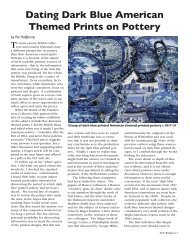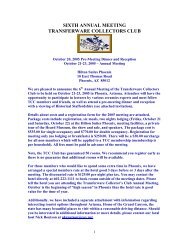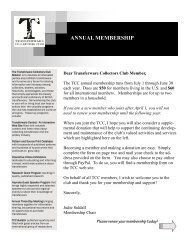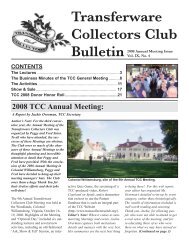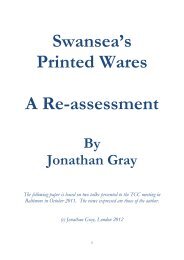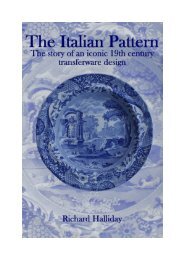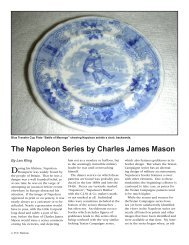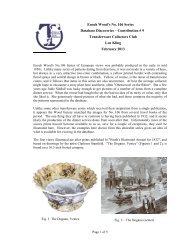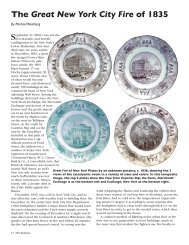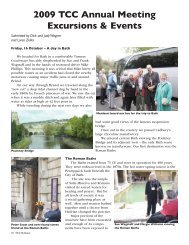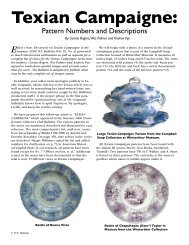download the publication - Transferware Collectors Club
download the publication - Transferware Collectors Club
download the publication - Transferware Collectors Club
Create successful ePaper yourself
Turn your PDF publications into a flip-book with our unique Google optimized e-Paper software.
The pattern is illustrated on a greenish-black printed, fluted teabowl and<br />
saucer, See Fig. 17, a blue-printed jug that carries <strong>the</strong> same border as <strong>the</strong><br />
teabowl and saucer See Fig.18. One example of this border is held in<br />
Swansea Museum. A third example is a punchbowl which has a distinctive<br />
border showing <strong>the</strong> ‘Two Kilns’ in oval cartouches on <strong>the</strong> sides of <strong>the</strong> bowl<br />
See Fig.19 whilst <strong>the</strong> interior of <strong>the</strong> punchbowl shows Rothwell’s<br />
‘Herdsman with Cattle, Farmhouse and Barn’ pattern See Fig.20.<br />
The identical distinctive border on <strong>the</strong> punchbowl and its ‘Herdsman,<br />
Cattle, Farmhouse and Barn’ pattern are also known on a jug that is<br />
dedicated to ‘George Sutton 1791’.* That <strong>the</strong> jug is dated 1791 is ra<strong>the</strong>r<br />
significant because Rothwell’s engravings of <strong>the</strong> Cambrian Pottery (done<br />
on paper and plaster of Paris) is dated ‘Augt.1791’ when he was in<br />
Swansea. This indicates that both <strong>the</strong> border and <strong>the</strong> ‘Herdsman, Cattle,<br />
Farmhouse and Barn’ pattern on <strong>the</strong> jug are contemporary with that date<br />
(1791), and that suggests that <strong>the</strong> punchbowl would be likely to be c. 1792.<br />
As mentioned previously, engraving done for paper is adapted and<br />
transposed into a simpler form for ceramics. This may be seen in<br />
Rothwell’s engraving of <strong>the</strong> Cambrian Pottery itself in August 1791. The<br />
coppers made for <strong>the</strong> pottery pieces were adjusted so <strong>the</strong> pattern would<br />
hold greater appeal for <strong>the</strong> market and also be more suitable for<br />
application on ceramics. Ceramic pots would have made good mementoes<br />
especially for people visiting <strong>the</strong> Pottery and buying on site which was, of<br />
course, practised at <strong>the</strong> Cambrian Pottery.<br />
Fig.18<br />
* Holdaway, M, Hollins Blue Printed Ear<strong>the</strong>nware Front cover image.<br />
39



